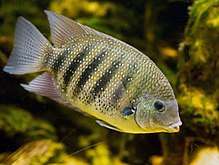Green chromide
The green chromide (Etroplus suratensis) is a species of cichlid fish that is native to fresh and brackish water habitats in southern India and Sri Lanka.[2] Other common names include pearlspot cichlid,[1] banded pearlspot, and striped chromide.[3] In Kerala in India it is known locally as the Karimeen.[4] In Goa the fish is known as Kalundar [5] In Sri Lanka this fish is known as Koraliya (කොරළියා).
| Green chromide | |
|---|---|
 | |
| Scientific classification | |
| Kingdom: | Animalia |
| Phylum: | Chordata |
| Class: | Actinopterygii |
| Order: | Cichliformes |
| Family: | Cichlidae |
| Genus: | Etroplus |
| Species: | E. suratensis |
| Binomial name | |
| Etroplus suratensis (Bloch, 1790) | |
It has been introduced in various parts of the world outside its native range,[1] including Singapore, where it occurs in estuaries.[6]
This species and other members of the genus Etroplus are relatively closely related to the Paretroplus cichlids from Madagascar.[7]
Habitat and behavior
The green chromide lives in brackish water habitat types, such as river deltas. It eats mainly aquatic plants, including filamentous algae and diatoms, but it consumes the occasional mollusk and other animal matter. This species engages in attentive parental care in which several adults care for each brood.[1]
Appearance
The adult is oval in shape with a short snout. It is gray-green in color with dark barring and a dark spot at the base of the pectoral fin.[1] It commonly reaches 20 cm (8 in) in length, and the maximum length is twice that.[2]
Relationship with humans
Etroplus suratensis is a popular food fish and it is considered a delicacy.[8]
Etroplus suratensis and E. maculatus form the main species and the former is dominant among Pearl spots in reservoirs of India. They mainly feed on detritus and occupy the same niche as that of Oreochromis mossambicus. These fishes are very popular food fishes but their biomass is very low in reservoirs compared to other cichlids.[9]
In 2010 this species was named the official state fish of Kerala. The following year was declared "The Year of the Karimeen". Karimeen Pollichatthu, a fried dish, is a delicacy served in restaurants. It is familiar to tourists, but because it is very expensive it is not easily accessible to poor folks. Production of the species for food is expected to increase in the near future.[4]
References
| Wikimedia Commons has media related to Etroplus suratensis. |
- Abraham, R. (2011). "Etroplus suratensis". The IUCN Red List of Threatened Species. 2011: e.T172368A6877592. doi:10.2305/IUCN.UK.2011-1.RLTS.T172368A6877592.en.
- Froese, Rainer and Pauly, Daniel, eds. (2011). "Etroplus suratensis" in FishBase. July 2011 version.
- Common names of Etroplus suratensis. FishBase. 2015.
- Basheer, K.P.M. (9 July 2010). "Karimeen leaps from frying pan to State fish". The Hindu. Retrieved 22 December 2019.
- "Good Goan Food: Local (Konkani) names for Common Fish in Goa". 2011-11-25.
- Green Chromide. Guide to Common Marine Fishes of Singapore.
- Sparks, John S. (2004). "Molecular phylogeny and biogeography of the Malagasy and South Asian cichlids (Teleostei: Perciformes: Cichlidae)". Molecular Phylogenetics and Evolution. 30 (3): 599–614. doi:10.1016/S1055-7903(03)00225-2. PMID 15012941.
- U.S. Fish and Wildlife Service April 2011.
- Feroz Khan, M.; Panikkar, Preetha (2009). "Assessment of impacts of invasive fishes on the food web structure and ecosystem properties of a tropical reservoir in India". Ecological Modelling. 220 (18): 2281–2290. doi:10.1016/j.ecolmodel.2009.05.020.
External links
- Pearl-spot. Fresh water fishes of Karnataka. ENVIS Centre.
For scientific information see Etroplus suratensis in Wikispecies
